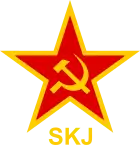4th Congress of the Communist Party of Yugoslavia
The 4th Congress of the Communist Party of Yugoslavia (Serbo-Croatian Latin: Četvrti kongres Komunističke partije Jugoslavije, Cyrillic: Четврти конгрес Комунистичке партије Југославије) was a congress of the Communist Party of Yugoslavia (CPY) held from 6 to 12 November 1928, in Zonenland, Dresden, in Weimar Republic. It was held outside Yugoslavia because the CPY was banned by the Yugoslav authorities.
Delegates
The delegates attending the congress included Sima Marković, Milorad Petrović, Živojin Pecarski,[1] and Kočo Racin.[2]
Destruction of Yugoslavia
The Communist Party of Yugoslavia set destruction of Yugoslavia as one of its main goals which was to be achieved by strict adherence to the right to the self determination of nations.[3] The strategy of the Communist Party of Yugoslavia relied on nationalistic anti-Serbian movements.[4] This strategy was based on the resolution of the Third Congress of the CPY aimed against Serbian bourgeoisie perceived as "oppresor" who evolved from "oppressive Serb people".[5] It was also based on the conclusions of the Fifth Congress of Comintern which posed the principle of "federal system of national states",[6] setting the stage for the Croatian secession, independence of Macedonia and supporting Albanian nationalistic movement.[7]
Croatian separatism
The 4th congress gave new impulse to the Croatian separatists and presented communists as deadly enemies of Yugoslav state.[8]
Montenegrin nation
At the Fourth Congress of the CPY in Dresden came up the first reference to the Montenegrin nation.[9]
References
- (Zlatić 1994, p. 241)
- (Adanır 2005, p. 110): "Although Koco Racin was not one of the new members of the young generation in a narrow sense - he was a Macedonian delegate at the fourth congress of the CPY in 1928 in Dresden -, he developed positions quite similar to theirs."
- (Tadić 1992, p. 19): "...КПЈ и КИ су поставиле као један од својих битних циљева разбијање Југославије помоћу стрик- тне примене права..."
- (Tadić 1992, p. 66): "... сукоба, када је на ред искрсло тзв хрватско национално питање, комунистичка стратегија се видно ослањала на националистичке антисрпске покрете. На четвртом конгресу... "
- (Đuretić 1993, p. 45):"... was corroborated by a resolution of the a resolution of the Third Conference of the CPY with the conclusion about the Serbian bourgeoisie as an "oppressor" evolved as a position on the "oppressive Serb people"",
- (Đuretić 1993, p. 45): "... At its Fifth Congress (in June 1924), the Comintern expanded its position by posing the principle of "federal system of national states"
- (BAS 2006): "In Dresden on the 4th congress of the party in 1928 the CPY accepting fully the principles of the Comintern stuck up for the secession of Croatia, establishing an independent Macedonia, supported the national movements of the Albanians, ..."
- (Đuretić 1997, p. 42): "Нови импулс хрватским сепаратистима пружио је Четврти конгрес КПЈ одржан у Дрездену 1928.године, сво- јим обрушавањем на југословенску државу на начин који је комунисте представио смртним непријатељима те државе."
- (Fleming 2002, p. 129): "The first reference to "Montenegri-nation" came at the fourth congress of the CPY in Dresden (1928), which also advocated"
Sources
- Zlatić, Jovan (1994). Politički život u Nišu između dva svetska rata: 1918-1941. Prosveta. ISBN 978-86-7455-136-3.
- Tadić, Ljubomir (1992). O "Velikosrpskom hegemonizmu". Stručna knj.
- Đuretić, Veselin (1997). Violence against the Serb uprising. Institut.
- Đuretić, Veselin (1993). Demolition of Serbs in the 20th Century: Background of the Currentdram in Dismembered Yugoslavia. Great Lakes Graphics.
- BAS (2006). Bulgarian historical review: Revue bulgare d'histoire. Publishing House of the Bulgarian Academy of Sciences.
- Adanır, Fikret (2005). Mitteilungsblatt des Instituts für soziale Bewegungen. Ruhr-Universität Bochum, Institut für Soziale Bewegungen.
- Fleming, Thomas (2002). Montenegro: The Divided Land. Chronicles Press. ISBN 978-0-9619364-9-5.
